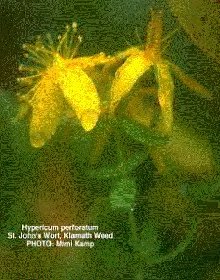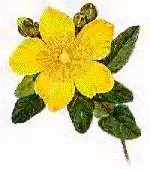

What is St. John's wort? This section is compiled by Frank M. Painter, D.C.
Send all comments or additions to: Frankp@chiro.org




Thanks to the University of North Carolina School of Pharmacy for the use of this article!
Chad Bradshaw, Anh Nguyen, and Jeff Surles

Description
- Shrubby, perennial plant
- Bright yellow flowers
- 1-3 feet tall erect plant
- Leaves and flowers contain medicinal effects
Other Common Names
- Goat Weed
- Klamath Weed
- Rosin Rose
- Amber touch and heal
- Tipton Weed
- From botanic family: hypericaceae
Regions of Growth
- Europe
- Britain

- North Africa
- Australia
- New Zealand
- Canada
History of St. John's Wort
- Hypericum perforatum: Greek for "over an apparition"
- Belief that the herb is "magical" because of its noxious odor
- Supposedly, evil spirits disliked the plant's odor, and thus could be warded away
Religious History
- Named after Saint John the Baptist
- The red spots on the leaves are symbolic of the blood of St. John
- Appeared on leaves on the anniversary of the Saint's beheading
- Therefore, best day to harvest plant: June 25
Other Interesting Historical Pieces...
- Sleep with the plant under your pillow on St. John's Eve: ensures vision of Saint John and obtains his blessing to prevent one's dying during the following year
- Soak plant in olive oil: symbolic of the blood of Christ
- Herbal remedy since the Middle Ages
Folk Uses
Early Applications
- nerve tonic: oldest indication
- neuralgia, mild to moderate depression, anxiety
- neuroses and insomnia
Recent Applications
- cancer treatment, AIDS
- diarrhea, nausea, sciatica, wound treatment, gastritis
Active Components
Hypericin:
- Treatment of depression
- Increases capillary flow
Other active compounds:
- Pseudohypericin: antiretroviral activity
- Tannins: for astringent effect
- Flavonoids, xanthones, phenolic carboxylic acids, essential oils, carotenoids, medium chain fatty acids
Pharmacology
- Antidepressant Activity
- Mechanism of Action?
- Antiviral Activity (in vitro)
- Herpes simplex virus types 1 and 2
- Influenza types A and B
- Vesicular stomatitis virus
- Epstein-Barr virus
- HIV?
- Antibacterial Activity - broad spectrum against both gram + and gram -
- Staphylococcus aureus
- Streptococcus mutans
- Proteus vulgaris
- Escherichia coli
- Pseudomonas aeruginosa
Clinical Applications
Depression
- Standardized extract containing 0.14% hypericin
- Has been used pharmacologically in Germany for years
- Doses of 300 mg TID are as effective in relieving symptoms of depression as standard antidepressants, but is much better tolerated with fewer side effects
AIDS & Other Viral Infections
- SJW may be a useful adjunctive treatment for herpes simplex, mononucleosis, and influenza
- Further human studies are needed to determine the optimal dosage
- May be a promising treatment for chronic fatigue syndrome
Numerous studies:
- 18 HIV patients received 2 mg hypericin/day
- Showed stable and increasing T-cell counts over the 40 months follow-up
- Most noteworthy: only 2 of the 16 encountered an opportunistic infection during the 40 month follow-up
- Trials so far have been disappointing
- Significant blood levels of hypericin could not be achieved using either oral or IV extracts
- Studies are now using a synthetic hypericin which is showing encouraging results in preliminary studies
Topical Applications
- Long been used as a wound-healing substance
- Antibacterial activity
- Have been used to treat burns and muscular pain
- Oily preparations preferred
Dosage
- Standardized fluid extract
- 300 mg TID
- Standardized solid (powdered dry) extract
- 0.3% hypericin: use 300 mg TID with meals
- Dried flowers
- 500-1000 mg
- Tincture
- 1-4 mL TID
- Dried herb infusion (tea): 1-2 grams
- Infusion Recipe
- 1-2 teaspoonfuls of dried herb to a cup of boiling water; Infuse for 10-15 minutes;
- Use TID
Toxicity
- Has caused severe photosensitivity in animals that graze extensively on the plant
- Reports in humans rare; limited to those taking excessive quantities for HIV
- Tyramine-containing foods?
- Drugs such as L-dopa and 5-HT
- Take with food to avoid mild gastric upset
Mechanism of Action
Antiviral:
- Inhibition of assembly or processing of intact virions from infected cells; released with no reverse transcriptase
- Directly inactivates mature and properly assembled retroviruses
Depression
- MAO Inhibitor?
- SSRI?
In Vitro Study
Thiede HM and A. Walper. Inhibition of MAO and COMT by Hypericum Extracts and Hypericin. J Geriatr Psychiatry Neurol 1994; 7(suppl 1): S54-S56.
Aim: to investigate the effects of hypericum and its fractions on in vitro activity of MAO and COMT
Fractions:

- Petroleum ether:ether (1:1)
- Ether
- Ether:acetone (8:2)
- Acetone
- Methanol:acetone (1:1)
- Methanol
- Fractions contained different constituents
Conclusions from Study
- To attribute inhibitory effect of MAO to hypericin, the inhibitory effect of the whole extract would need to have been 100 to 1000 times weaker
- However, concentrations of the whole extract required to inhibit MAO were actually 100 times lower (Lower concns of whole extract provided MORE enzyme inhibition that fractions of hypericin alone)
- Thus, other constituents must have contributed to the inhibition
- In vitro concentrations of hypericin that inhibit MAO are in no way adequate to explain the antidepressant effect of the hypericum
- Implies that other constituents as well as other mechanisms of action must be responsible for the antidepressant effect of hypericum.
Mechanism of Action
- MAO may be inhibited to a small extent.
- Unlikely that this is the mechanism of antidepressant effect
Clinical Trial 1
Vorbach e., Hubner, W, and K.H. Arnoldt. Effectiveness and Tolerance of the Hypericum Extract LI 160 in Comparison with Imipramine: Randomized Double-Blind Study with 135 Outpatients. J Geriatr Psychiatry Neurol 1997; 7(suppl 1): S19-S23.
- Study conducted from October 1992 to May 1993
- Multi-Centered (20), randomized, double-blinded
- Sample size = 135; 130 completed study
- Groups were not significantly different
Dosage:
- St. John's Wort: 3 x 300 mg
- Imipramine: 3 x 25 mg (usual dose of imipramine is 50-150 mg)
- Capsules were indistinguishable in form, color, taste, and consistency
Study duration: 6 weeks
Inclusion Criteria:
- Typical depression according to DSM-III-R with a single or recurrent episode(s)
- Neurotic depression
- Adjustment disorder with depressed mood
Exclusion Criteria:
- Severe depression requiring inpatient treatment
- Schizophrenia or marked agitation requiring additional drug therapy
- Known history of attempted suicide or acute suicidal state
Target Variables:
- Hamilton Depression Scale (HAMD)
- Von Zerssen Depression Scale (D-S)
- Clinical Global Impressions (CGI)
- Compliance monitored by counting number of returned capsules
Results
Hamilton Depression Scale
- SJW: 56% improvement (20.2 to 8.8)
- Imipramine: 45% improvement (19.4 to 10.7)
Von Zerssen Depression Scale
- SJW: 39.6 to 27.2
- Imipramine: 39.0 to 29.2
Clinical Global Impressions (CGI)
Therapeutic Effect
- SJW: 1.3 to 3.1
- Imipramine: 1.2 to 2.7
Change in severity of illness
- SJW: 81.8% improved, 18.2% unchanged
- Imipramine: 62.5% improved, 34.4% unchanged
Change in Status Following Treatment
- SJW showed a slightly larger magnitude of positive change
Undesired Effects
Experienced by 8 patients on SJW (11.9%)
- 11 symptoms, most frequently being dry mouth and dizziness
Experienced by 11 patients on Imipramine (16.2%)
- 22 symptoms, most frequently being dry mouth, dizziness, anxiety, and constipation)
Other Effects
- No clinically relevant changes in either group with respect to BP, HR, HGB, RBC, Leukocytes, platelets, WBC (including differential), AST, ALT, Alkaline phosphatase, or creatinine)
Conclusion
- Hypericum (St. John's Wort) extract proved to be as efficacious as Imipramine with fewer adverse effects
Clinical Trial 2
Sommer H and G Harver. Placebo-Controlled Double-Blind Study Examining the Effectiveness of an Hypericum Preparation in 105 Mildly Depressed Patients. J Geriatr Psychiatry Neurol 1994; 7(suppl 1): S9-S11.
- Multicenter (3), Randomized, Double-Blind study
Admission criteria:
- 25-65 years old
- with depressive symptoms according to ICD-09 300.4 (neurotic depression) and 309.0 (brief depressive reaction)
Exclusion Criteria:
- Severe renal or hepatic dysfunction
- Heart failure
- Parkinson's Disease
- Endocrine or CNS tumors
- Alcohol/Drug/Medication dependency
- Pregnancy or lactation
- Prior psychoactive drug use within 4 weeks
Dose:
- 3 x 300 mg SJW
- Placebo
Results:
- Responder classified as one whose total HAMD score fell to less than 10 or by 50% of baseline value
- 96 patients completed the trial
- Both groups displayed similar HAMD scores
- By week 2, significant improvement in both groups
- By week 3, placebo group only slightly improved, whereas SJW group continued to improve steadily
- SJW particularly helped with these symptoms:
- Feelings of sadness, hopelessness, helplessness, worthlessness
- Difficulty initiating sleep/Disordered sleep
- Psychological anxiety
- Feelings of guilt
- Responders:
- 67% of patients in SJW group
- 28% of patients in placebo group
- Undesired Effects: Occurred in two patients on SJW
- Skin Reddening
- Itching
- Fatigue
Conclusion:
- Hypericum extract is a low risk antidepressant for treatment of mild and moderate depression, with the advantage of reliable antidepressant efficacy and a minimum of side effects.
In conclusion...
- St. John's Wort has shown antidepressant effects equal to conventional pharmaceutical agents, with fewer side effects.
- The mechanism of action of St. John's Wort is not fully understood.

Return to ST. JOHN's WORT


| Home Page | Visit Our Sponsors | Become a Sponsor |
Please read our DISCLAIMER |